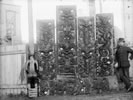Identifying and classifying
From the 19th century some people began urging that places and objects significant in New Zealand history should be kept for future generations. Historic reserves were created from the 1890s, and from 1906 were cared for by the Department of Lands and Survey. Some notable buildings received government protection, and after the Historic Places Trust (later called Heritage New Zealand) was set up in 1955, more sites and structures were identified and protected, sometimes by purchase.
The Colonial Museum (later the National Museum) began systematically collecting Māori artefacts from 1903, and in the 1920s and 1930s it and the growing number of regional museums also expanded collections of objects relating to both Māori and Pākehā history.
Most identifying and classifying of sites and objects was originally done by unpaid historians. For example, many members of Historic Places Trust regional committees researched sites. In museums volunteers often cared for the history collections.
Historic reserves
Former Surveyor-General S. Percy Smith, amateur historian and co-founder of the Polynesian Society, and Hoani Tunuiarangi, Rangitāne and Ngāti Kahungunu leader, were members of the Scenery Preservation Commission of 1904–06, responsible for identifying many early historic reserves under the Scenery Preservation Act 1903. These reserves included ancient pa sites, and places connected with the history of colonisation including sites of battles of the New Zealand Wars. Many were located in Taranaki, where Percy Smith lived. However, as the name of the commission implied, natural heritage was valued above historic heritage – an attitude that persisted.
Analysing and understanding
Museums began to employ trained historians from the late 1960s. At the Dominion Museum the impending Cook bicentennial led to the appointment of the first ‘curator of colonial history’ in 1968. Other museums followed suit, and the numbers of history curators grew. As well as building and researching collections, curators answered public queries and advised government officials on objects protected by legislation.
Law changes governing historic places and reserves from the 1970s prompted the employment of more professional historians – often on short-term contracts or employment schemes – to do in-depth historical research and assessment. From 1977 the Department of Lands and Survey was obliged to produce management plans for historic reserves, and the Historic Places Trust had to keep a register of pre-1900 archaeological sites from 1975. From 1980 the trust’s role in classifying buildings was formalised, and from 1993 its regulatory powers were extended and it was required to keep a consolidated register of both buildings and sites.
With the introduction of the Resource Management Act 1991, regional and local authorities had heavier obligations to identify and protect historic places with reference to the Historic Places Trust register, so they often employed historians to help assess the significance of sites and buildings.
Different points of view
Conflict between experts from different professions has been particularly noticeable in the field of historic heritage. Assessments of a building’s significance can be quite different, depending on whether an architect or historian is viewing it. Historian Ruth Ross, who was on the New Zealand Historic Places Trust classification committee in the late 1960s, insisted that judgements should be based on ‘intrinsic historical, architectural and environmental merit’1 to ensure they were properly balanced.
Interpretation
From the 1970s the importance of historical interpretation became accepted. This contrasted with the old practice of putting brief markers on sites and labels on objects. Now visitors to historic places or museums were encouraged to engage with the past in a more imaginative way. Historians at the Department of Lands and Survey (and after 1987 the Department of Conservation) began to use illustrated signs, leaflets, displays and videos in ‘visitor centres’ to explain the significance of sites. Similar methods were used by Historic Places Trust (later Heritage New Zealand), which placed increasing emphasis on authenticity in the restoration and furnishing of its properties.
In museums interpretation became even more sophisticated. The recreated colonial room or street, common from the 1940s, had by the 1990s given way to exhibitions that combined disparate items, including artworks, objects, film clips, sound and interactive elements. The history curator now worked with other museum staff to create these layered exhibitions. From the 1990s websites and digital resources became important in helping to interpret places and objects.










